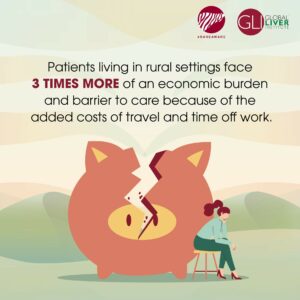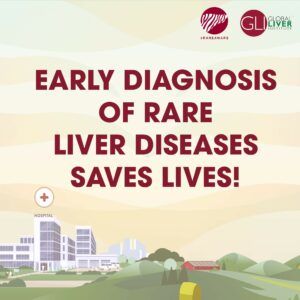As we observe Rare Liver Disease Month this February, touchENDOCRINOLOGY is proud to join Global Liver Institute (GLI) in championing awareness for rare liver diseases.
Although primarily managed within hepatology, many rare liver diseases have strong links to endocrinology due to their metabolic, hormonal and genetic implications. Understanding and raising awareness of these connections is a crucial part of early diagnosis and improving patient outcomes, particularly in rural communities where access to specialized care may be increasingly limited.

Since 2005, 190 rural hospitals have closed in the USA and 700 more are at risk.1 Studies from around the world have shown that conditions such as biliary atresia and other genetic disorders are not only more prevalent but are often diagnosed later in rural populations due to the lack of specialized care.2,3 Through its annual #RareAware campaign, GLI seeks to tackle these disparities by bringing rare liver diseases to the forefront and encouraging conversations online and within communities.
“My own experience as a patient in a rural area taught me how vital it is to share our stories and raise awareness. In rural and underserved areas, people listen to those who sound like them, live near them, or share similar experiences,” said Kristin Hatcher, GLI’s Program Director of Pediatric and Rare Liver Disease and rare liver disease patient advocate. “When rare liver diseases become part of everyday conversations, especially among friends, family and neighbours, it creates a ripple effect. It can truly make the difference between life and death.”
Under the theme ‘Rare and Rural’, the campaign aims to fuel curiosity, inspire action and drive greater research efforts to address the unique challenges faced by rare liver disease patients in rural areas, ultimately leading to earlier diagnoses and saving lives.

Larry R Holden, CEO of GLI, highlights the urgency: “Normalizing conversations about rare liver diseases is key to breaking barriers to diagnosis, especially in rural areas where healthcare resources are scarce. By increasing awareness, we can address critical disparities in rare liver disease diagnosis and care, particularly in underserved rural areas, and empower individuals and communities to act early.”
The Global Liver Institute’s goals for 2025:4
- Deliver rare liver disease education to medical schools in rural communities in the USA.
- Engage 30+ students in underserved areas in hands-on research and advocacy about the impact of rare liver diseases on their communities.
- Share the stories of 10+ patients with rare disease from rural areas, amplifying their experiences and raising awareness.
- Build and share a comprehensive list of support and educational resources for patients with rare disease in rural communities.
- Lead in-person advocacy efforts, using patient data and research to drive policy changes for rural healthcare.
A new component of their campaign this year is the Rare Science Fairs. An initiative that empowers students from underserved communities to explore evidence-based liver research, uncover the impact of rare liver diseases, and educate their peers and local communities through research posters. By participating, students not only gain knowledge about the research process but also help elevate the role of patient advocacy groups in driving awareness and change. This initiative fosters rare disease allies, equipping them with the knowledge and passion to lead grassroots efforts and pursue careers in patient advocacy, nonprofits and public health.
We urge all our touchENDOCRINOLOGY readers to join the conversation this Rare Liver Disease Month. Whether through social media, local discussions or educational outreach, your voice can play a vital role in raising awareness of rare liver diseases, supporting early diagnosis and promoting equitable care. For more information, you can visit the GLI website, where you will find resources including a social media toolkit and educational videos featuring conversations between experts and patients.
References
- Olsen E. More than 700 rural hospitals at risk of closing: Report. [News article]. 2024. Available at: www.healthcaredive.com/news/hundreds-rural-hospitals-risk-closing-center-healthcare-quality-payment-reform/723555/ (accessed 11 February 2025).
- Global Liver Institute. Rural Communities at Risk: Global Liver Institute Champions Awareness for Rare Liver Diseases. [Press release]. 2025. Available at: https://globalliver.org/rural-communities-at-risk-global-liver-institute-champions-awareness-for-rare-liver-diseases/ (accessed 11 February 2025)
- Nomden M, van Wessel DBE, Ioannou S, et al. A higher incidence of isolated biliary atresia in rural areas: Results from an epidemiological study in the Netherlands. J Pediatr Gastroenterol Nutr. 2021;72:202–9. doi: 10.1097/MPG.0000000000002916.
- Global Liver Institute. Rare Liver Diseases Month. 2025. Available at: https://globalliver.org/rare-liver-diseases-month/ (accessed 11 February 2025).
Disclosures: Images and quotes were provided to touchENDOCRINOLOGY by the Global Liver Institute (GLI). No fees or funding were associated with this short publication.
Image: © 2024. Global Liver Institute.
Acknowledgement: Editorial Assistance was provided by Gina Furnival, Senior Editorial Director, Touch Medical Media.
SIGN UP to touchENDOCRINOLOGY!
Join our global community today for access to thousands of peer-reviewed articles, expert insights, and learn-on-the-go education across 150+ specialties, plus concise email updates and newsletters so you never miss out.



